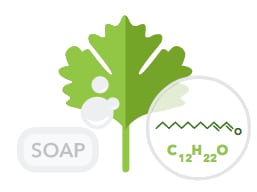There’s a day for almost everything, so, of course, there’s an international “I Hate Coriander Day.”
Coriander, also known as cilantro, is one of the most commonly used herbs in the world, but people’s preferences for this little leafy green are one more thing that divides them.
For some, it is baffling why anyone would feel such a passionate loathing for an ingredient that brings a distinctive tang to their guacamole. Meanwhile, others cringe in disgust at tasting anything with what they think of as a “devil herb.”

(23andMe customers can learn about the genetics of their Cilantro taste preference in their trait report here. If you’re curious about this or other reports but not yet a customer, check out our DNA Tests to get a customized genetic traits report.)
Cilantro Tastes Like Soap
As one former 23andMe blogger said in an old ode to cilantro hatred:
“For years I believed that every Mexican restaurant my family took me to had some kind of problem with their dishwashing machine. Why else would the food always taste like soap?”
Many people have no idea that this leafy green herb can cause such repulsion, much to the chagrin of those who find it foul. For some, cilantro tastes like soap. To others, it can taste like stink bugs, dirt, or — if they’re feeling really dramatic – anarchy, pure evil, or the plague.
Cilantro Taste Aversion
Like with anything that divides people, it’s helpful to understand where the other side is coming from. And we at 23andMe are here to help with a bit of science.
Several years back, a team of 23andMe scientists found a “genetic component to cilantro taste perception.” The findings suggested that genetic variants in the olfactory receptors may contribute to some people’s distaste for cilantro.
23andMe also offers customers a Cilantro Taste Aversion Trait Report that looks at two genetic variants associated with a dislike for cilantro and can tell you if you have slightly higher or lower odds of disliking the herb.
While genetics plays a role, culture and environment do, too. Some of that may explain the differences between people of different ancestries. In the 23andMe study, we found that 14-21 percent of people of East Asian, African, and Caucasian ancestry disliked cilantro, while only 3-to-7 percent of those who identified as South Asian, Hispanic, or Middle Eastern disliked it.
But clearly, your environment or your cultural cuisine isn’t everything. Genetics also plays a role in this love-hate relationship.
Cilantro & Genetics
Cilantro taste in 23andMe customers
Cilantro soapy-taste by ancestry
| Ashkenazi Jewish | 14.1% |
| Southern European | 13.4% |
| Northern European | 12.8% |
| African-American | 9.2% |
| Latino | 8.7% |
| East Asian | 8.4% |
| South Asian | 3.9% |
Sex differences in cilantro taste perception
| Female vs. Male | |
| Tastes soapy | 57% vs. 43% |
| Doesn’t taste soapy | 49% vs. 51% |
Humans have hundreds of receptors that send signals to our brains to produce what we recognize as aromas and flavors.
However, this is complex and differs from person to person. For example, the same chemical can be found in appealing and unappealing places — cheese and body odor. Conversely, the same ingredient — such as cilantro — can contain both pleasant and unpleasant chemicals. Whether stinky cheese and cilantro are delicious or disgusting depends on your perception of many different substances.
The two genetic variants used in 23andMe’s Cilantro Taste Aversion trait report are in a cluster of olfactory receptor genes. These are biological sensors that detect chemicals in the air and in food. These receptor genes are also linked to the ability to detect aldehydes, chemical compounds found in soap and thought to be a major component of cilantro aroma.
Supertasters
One type of aldehyde has been described as “fruity” and “green” and another as “soapy” and “pungent.”
One of the eight genes near the variants 23andMe uses in its report codes for a receptor called OR6A2, known to detect aldehydes such as those found in cilantro. Although this finding proves that genetic variation in olfactory receptors is involved in cilantro taste perception, common genetic variants explain only a tiny part of the difference — a half percent — between 23andMe customers for this trait.
This doesn’t mean that genetics can’t play a significant role in a particular person. Indeed, some people are “supertasters” or may have specific genetic variations that cause them to detect or not detect certain smells and flavors. One thing’s for sure—if you hate cilantro, you really hate cilantro!
Learn More
If you aren’t already a 23andMe customer, check out your Cilantro Taste Aversion trait report here. Not yet a customer? Find out more here.